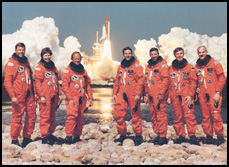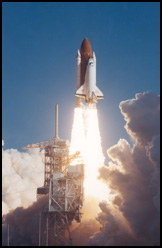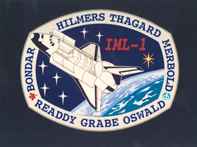
![]()
Home • Collection • Biography • Canadian Astronauts • Mission STS-42 • Microgravity Lab • Homecoming
Mission STS-42
After a delay of one hour for weather, Space shuttle Mission STS-42 began with the launch of the "Discovery" from the Kennedy Space Center in Florida at 9:52 AM on January 22, 1992. The crew consisted of Commander Ronald J. Grabe, a veteran of two previous missions, Pilot Stephan S. Oswald, Payload Commander Norman E. Thagard, Mission Specialists, William F. Ready and David C. Hilmers and Payload specialists Roberta L. Bondar and Ulf Merbold.
The objective of this mission was to conduct science and technology investigations that require the low gravity environment of space. The experiments studied the affects of microgravity laboratory and involved over 200 scientists from 14 countries. Aboard the shuttle, located in the cargo bay was the European developed Spacelab which had been fitted to conduct the over 40 experiments during this flight. In order to achieve the lowest possible gravity levels for the experiments the orbiter was maneuvered so that its tail pointed toward the earth. The crew could maintain this stable position without firing the maneuvering jets so as not to disturb the delicate experiments being performed. Initially the mission was to last seven days however the crew was able to conserve sufficient fuel, electricity, water and air that the mission was extended by a day. This extra day together with both the orbiter and payload crews working in twelve -hour shifts increased the scientific data collected on this mission.
After 8 days, 1 hour, 15 minutes and 129 orbits of the earth, the shuttle "Discovery" landed at Edwards Air Force Base in California on January 30, 1992.
 |
 |
 |
STS-42 Crew |
Mission STS-42 Launch |
IML-1 Insignia |
Photos Courtesy of NASA
